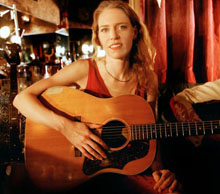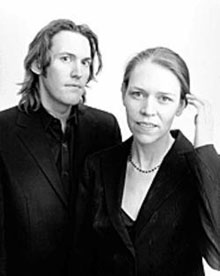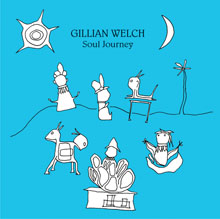Look At Miss Ohio
 |
When you find yourself turning to Gillian Welch for a more "contemporary" sound, you know you've been tilting pretty far to the traditional end of the musical spectrum. She—or more accurately, "they", to acknowledge the critical contributions of her partner David Rawlings—has made a name for herself by sounding so authentically old-fashioned. One of the most common questions she gets in interviews is some variation on, "So how's a modern California girl like you end up sounding like Mother Maybelle?"
Her answer to that question—if I may be so bold as to sum things up for her—is some variation on, "Love."
From the first time she heard a live recording of the Stanley Brothers, she has loved mountain music. She soon learned that it loved her right back, first as a guitarist and singer, later as a songwriter. She and Rawlings blend vocally and instrumentally as well as any of the sibling performers—Blue Sky Boys, Delmore Brothers, Carter Family—that inspired them. Which is saying something, indeed. But they have not only tread that well-worn mountain path; they have widened it and deepened it. Several of their songs have quickly established themselves as standards among contemporary bluegrass, old-time and alt-country musicians. We will no doubt add more of them to our Community Guitar repertoire over time.
 |
Look At Miss Ohio does not provide a good example of Welch's gift for crafting neo-traditional songs, but then, we've got plenty of the non-neo variety. The song has—what shall we call it?—a folk-rock groove. You can hear the drums, even when they aren't there. Definitely a rhythmic style you've wanted under your guitar strap ever since The Byrds and The Band had their way with the songs of young Bob Dylan.
Still, even if all you've got is a couple acoustic guitars, Miss Ohio serves as a fine jam vehicle, especially if you are willing, as we are, to take a minor liberty with the song's structure by leaving out the Am-D7 instrumental interlude. That interlude serves an important purpose when the song is offered up as a performance piece. The verses and chorus share the same melody and chord structure, and the song has no bridge, so the interlude breaks the aural monotony in two ways: by providing a new harmonic progression and by occasionally shifting the focus from Welch's vocals to Rawlings' instrumental breaks.
In a jam situation, though, the benefits of structural simplicity almost always trump those of complexity. Especially when a series of instrumentalists are taking solos between vocals, you don't want to be guessing whether you have to play over the verse, the chorus, the bridge or the refreshing instrumental interlude. It's hard enough to improvise even when you know what's coming, thankyouverymuch. So in the interest of predictability we'll be dropping the interlude and taking solos over the song's verse/chorus.
 |
On the accompanying video you can see how Rawlings himself approaches the task in the solo that comes in at around 3:05. Our third solo borrows heavily from this one, though with some significant differences. For one, his chorus is played in the upper reaches of the fingerboard, including a fast triplet run way up beyond the 14th fret. I've included much of that flashy (and challenging) section of his solo, but changed the fingering of it and brought it down an octave in the interest of accesibility. The lower fretboard position of that section of the solo suggested a different position and fingering for the rest of it too, as well as opening up other possibilites. Which is precisely what make solo transcription so fruitful: spend time trying to understand what a gifted musician is up to and next thing you know, they've passed a gift along to you.
Keeping that in mind, do right now and give this video a close watch and listen.
Video: Gillian Welch and David Rawlings perform Look At Miss Ohio from their CD Soul Journey.
All Community Guitar Resources text & material © 2006 Andrew Lawrence
